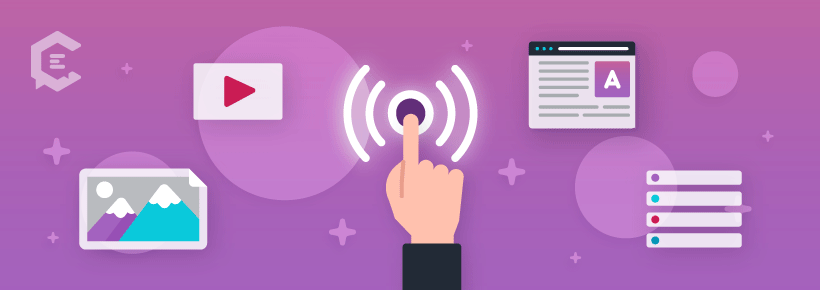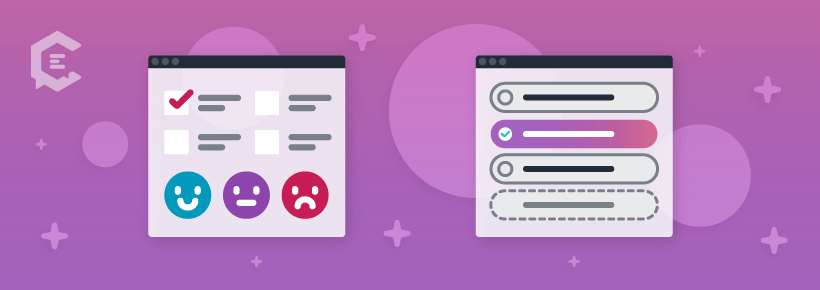One-way communication is a thing of the past. Trend forecasters and content marketing experts note that exhibitionist content (vlogs, static Instagram posts) are on a downswing, while interactive content marketing is taking over. It engages people, it sparks conversation, and many times it can teach the brand something about customers and market trends. The question is, how do you create a piece of content that will engage and spark quality conversation?
Even if you’re not a dynamo who can jump into the ever-changing viral meme conversation on Twitter, there are still ways to become comfortable with creating this style of content — and pull your audience into the conversation as you hope to do.

What is interactive content marketing?
Interactive content requires users’ collaboration, and interactive content marketing utilizes that style of content to provide value, exchange information, attract and convert customers.
Types of interactive content
- Assessments
- Polls
- Calculators
- Interactive infographics
- Workbooks
- Giveaways
- Challenges
The challenge of creating quality interactive content
The laziest, least engaging form of interactive content is often seen in Instagram or Facebook posts, where the caption starts with a statement or personal anecdote and then asks “What about you guys? What’s your favorite __? Do you ever feel like this?” There’s nothing sincerely interesting about this type of content; it just attempts to turn a one-way thought stream into a conversation by tagging on a generic question. Don’t rely on it.
The most creative format of interactive content is also one that doesn’t require collaboration, just inspires it — and almost always organically. I’m talking about the meme.
We don’t know exactly why the “woman yelling at cat” meme had such widespread appeal and a relatively long lifespan, but something about it inspired people who normally stay out of the meme world to attempt creating their own version. Few businesses could find a way into this cultural moment, though.
Another example, and easier to piggyback on, was Baby Yoda. The breakout star of the ‘Mandalorian’ spawned a thousand memes seemingly overnight, and all kinds of businesses from GameSpot to the Sacramento Kings were in on the fun. In spite of Disney’s notoriously protective copyright policies, no one wanted to stop posting modified photos and GIFs of the little green guy. Why? Because everyone loved him — consumers and content professionals alike. This shows the power of interactive content to reach across the globe and inspire pure shared enjoyment.
As content marketers, we hope to harness just the tiniest fragment of that engagement, but for a different purpose than entertainment value alone. We hope to provide some sort of value, perhaps providing useful information or a solution. Or, we actively seek feedback that the user wants to give. We use this as a starting point to build a relationship, and ultimately to convert and retain the customer.
Interactive content marketing that converts
While people are more skeptical than ever about sharing their data, they are very used to sharing their opinions on a topic or their versions of a joke. So today’s most popular types of interactive content from marketers typically seek to elicit opinions or provide customized information rather than sneakily attempting to harvest data.
Breaking down the types of interactive content used in content marketing
1. Assessments
This goes in a category with quizzes, but people have soured on internet quizzes since Cambridge Analytica. Assessments have more of a purpose than figuring out “What ‘Game of Thrones’ character would you marry?” They are a series of questions that lead the user to a product or service recommendation. Assessments are used in every product category from cosmetics to accounting software.
2. Polls
This goes in the same category as surveys, but since people’s inboxes are inundated lately with customer satisfaction surveys after every transaction or online experience, I recommend staying away from surveys and coming up with an attention-grabbing poll instead. You can place them everywhere from Twitter to Instagram Stories to a pop-up on your website.
3. Calculators
There are certain sectors where interactive calculators are heavily used — financial services sites like Credit Karma and real estate iBuying sites like Redfin among them. Although interactive calculators don’t seem particularly sexy, they can be addictive for people who are actively shopping for something, such as a new car or house. They also capture valuable data for marketers. When someone is running the numbers on a potential purchase, you learn what their budget range and overall financial picture is. You also get the general product specs they are interested in, and with more sophisticated software, your site can serve them options that may fit their needs.
4. Interactive infographics
Infographics have been popular for several years now, and marketers say the new interactive ones are reigniting user interest that the static ones lost bit by bit. They’re more complex to produce than static, but can present information — whether complex or mundane — in a visual, dynamic way that really captures attention.
Memorable interactive infographics to check out:
- Hungry Tech Giants from Simply Business
- See How Your Salary Compares on the Wall Street Journal
- Global Threat Interactive (What’s the World Scared of?) from the Guardian
- Will a Robot Take Your Job? from the BBC
5. Interactive video training
While some marketing experts say that interactive video is a compelling format, I find that the interactivity part is limited by tech, budget and the producer’s creativity. With most interactive videos, even if the host is encouraging users to perform an activity or choose something, there’s little connection between those words and what happens next in the video.
If you have a decent budget and can incorporate quizzes, user activities and other elements throughout the video, it can become a powerful tool because it combines e-learning with an in-depth intro to a brand or product.
6. Challenges
Often seen in the health and wellness space, challenges demand a long-term commitment from users, and therefore have a low completion rate. That doesn’t exactly matter though, because once someone’s signed up on a challenge app or input their info into an online form, the creator of the challenge has it. From that point, content strategy becomes a combination of encouraging people to work toward their goals and familiarizing them with your company… all with the data insights that they’ve provided freely.
7. Giveaways
When companies aren’t sure what type of content will engage their target customer, and they want maximum reach in the least amount of time, they almost always turn to giveaways. And why not? Giveaways work, especially when promoted on social media. As a rule, the higher the value/more desirable the item, the more engagement you’ll get.
Make sure you follow the platform terms of service wherever you post — for example, Facebook doesn’t like “tag yourself” or “tag a friend” calls to action, and will often take down giveaways that instruct people to do this in order to enter. As long as you comply with platform rules, the giveaway is an interactive content tool that requires little effort on the creator’s end or the user. The most important step for you is making sure you capture the highest possible number of new leads.
And more…
There are other types of content that some say fall into the broad interactive category, sometimes in the sense that the user has choices over how the content is presented, and sometimes in the sense that they’re actually interacting with another person. Chatbots are often grouped into the latter sub-category, but the issue with chatbots is that most people really prefer to talk to a real person. A chatbot makes a good answering service, but can’t replace real customer service.
Webinars also are sometimes put into the interactive content category, but we use them more as educational products than part of the marketing toolbox here at ClearVoice.
Remember, one key to effective interactive content marketing is genuine interaction between you/your team/your company and the users or audience. That’s why bots can only go so far. Another key component is that you need to provide value and spark interest, or the audience won’t stick around.







